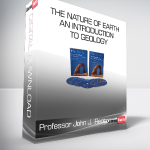Professor John J. Renton – The Nature of Earth – An Introduction to Geology
Original price was: $319.95.$62.00Current price is: $62.00.
Equipped with knowledge of both the large and small scales, you then venture into the field to explore: volcanism, mass wasting, weathering and soils, the sculpting of the land, groundwater, rock deformation and geologic structures, earthquakes, mountains, and the economic geology of coal and petroleum.
- Description
- Reviews (0)
Description
Professor John J. Renton – The Nature of Earth – An Introduction to Geology
A Science That Is Intuitive, Accessible, Concrete, and Exciting
Wherever you live or travel, geology is everywhere. Wouldn’t you like to know how to read the rocks and landscape; how to make sense of debates over natural resources; and how to appreciate the “deep time” that governs a geologist’s sweeping perspective?
These 36 half-hour lectures are your initiation into the geological world that lies just outside your door. The Nature of Earth: An Introduction to Geology introduces you to physical geology, the study of Earth’s minerals, rocks, soils, and the processes that operate on them through time.
No other science deals more practically with the world on which we live, telling us where to dig a well; when to add lime to soil; how gold, oil, and other valuable minerals are formed and where to find them; what kinds of structures are safest in an earthquake zone; and why some active volcanoes are deadlier than others—far deadlier.
Geology also unlocks the history that lies hidden in the land all around us—in a piece of marble, a hillside, a handful of sand, the rock layers of a road cut, or the jagged peaks of a mountain range.
And for anyone who feels hesitant about the inherent complexity of sciences such as biology and physics, geology is surprisingly intuitive, accessible, and concrete. At the same time, it has the excitement of a never-ending detective story, replete with clues to the complex past of our planet.
Learn the Principles from a Master Educator
Geologists themselves are much like their subject matter: plainspoken, no-nonsense, rugged, and with a tinge of romanticism. This accurately describes your instructor for this course, Professor John J. Renton, an award-winning educator at West Virginia University, where he holds the Eberly Family Chair for Distinguished Teaching.
A widely respected expert on the geology of coal, Professor Renton’s first love is teaching introductory geology, which he has pursued at West Virginia University with enthusiasm and creativity for more than 40 years. He recalls that as a young faculty member he set aside his lecture notes to try something that would encourage more involvement among his students. He decided to approach each class as an actor would a one-act play. Ever since, he prepares a script, rehearses it for hours, and then destroys it afterward to avoid using the same presentation year after year.
You will find Dr. Renton spontaneous, easy to follow, funny, and extremely well organized. He has a gift for picking simple analogies that make complicated concepts clear and memorable. For example:
The moving sidewalk: We have all heard of continental drift, but do the continents really move? Not exactly, says Professor Renton. They are like passengers on a moving sidewalk: the passengers don’t move, but the sidewalk does. In the same way, the continents are being carried atop the slowly moving plates of Earth’s crust.
The fish poacher: What makes Earth’s plates move? A fish poacher—an elongated pot designed to fit over two burners on a stove—illustrates the principle in action. In a fish poacher, two heat sources produce alternating cells of rising and sinking water. Similarly, Earth’s internal heat creates alternating cells of rising and sinking magma. Earth’s plates are driven apart where the currents are rising, and they are forced together where the currents are sinking.
The bottle of champagne: A volcano erupts explosively for the same reason that a too-hastily-opened bottle of champagne spews out much of its contents. As magma nears the surface, built-up pressure is suddenly released, causing dissolved gases to come out of solution and expand explosively. In champagne, something similar happens when the cork is popped.
An Innovative Curriculum
As an old hand at teaching new students in geology, Professor Renton has developed an innovative and highly effective curriculum.
After beginning with an overview of Earth’s place in the universe, you move directly to the most important unifying concept ever developed in the science of geology: plate tectonics. An understanding of this beautiful idea places other topics such as mountain building and seismology in crystal-clear perspective.
With this “big picture” introduction complete, you shift to the microworld of molecules, atoms, and subatomic particles to gain a basic understanding of minerals, which are the building blocks of rocks and soils. From there you move to the three types of rocks: igneous, sedimentary, and metamorphic.
Dr. Renton does not ignore terminology, and you will acquire a geological vocabulary that includes such terms as “mafic” and “felsic” (classifications of igneous rock), “lithification” (the process that turns sand into sandstone, for example), and “gneiss” (the most abundant of all metamorphic rocks).
He always explains and puts concepts into context so that you will genuinely understand why “granitic” magma very rarely rises to the surface, but when it does, it produces an eruption of unimaginable violence—and also why the marker for such an event having occurred in the past is a fine grained rock called “rhyolite.”
Explore a Range of Topics in Geology
Equipped with knowledge of both the large and small scales, you then venture into the field to explore: volcanism, mass wasting, weathering and soils, the sculpting of the land, groundwater, rock deformation and geologic structures, earthquakes, mountains, and the economic geology of coal and petroleum.
Covering the bulk of the course, these lectures take you to some fascinating places—from the bituminous coal fields of Dr. Renton’s home state of West Virginia to the mid-ocean ridges, the most prominent feature on our planet (if you drain away the water). But you also explore your own backyard in lectures that focus on soils and groundwater, two issues that are critically important to everyone.The ability of grain crops to flourish in some areas and not others will suddenly make sense, and so will the rising, falling, and sometimes puzzling behavior of the water table.
Get Professor John J. Renton – The Nature of Earth – An Introduction to Geology download
In this section of the course, you also put your knowledge of plate tectonics to work, addressing such questions as:
How do you recognize a killer volcano? Because of differing magma chemistry, volcanoes along the margin of colliding plates are much more dangerous than those where plates are pulling apart. The former include Mount St. Helens in the United States and Mount Pinatubo in the Philippines, among many others. The latter include the numerous active volcanoes on Iceland, which rarely harm anyone.
What is the evidence that a collision formed the Appalachian Mountains? As you travel west across the Piedmont, the Blue Ridge Mountains, the Shenandoah Valley, and the Appalachians, the crumpling of rock strata becomes increasingly less pronounced, showing that the energy that went into producing the folds came from the east—exactly what you would expect for a collision of continents occurring in what is now the Piedmont region.
Where is the colliding continent that produced the Appalachians? It’s called Africa. The Atlas Mountains in northwest Africa are structurally a mirror image of the Appalachians. Africa separated from North America in the breakup of Pangaea that began about 180 million years ago.
What caused the bend in the Hawaiian Island–Emperor Seamount chain? The motion of the Pacific plate over a geologic hot spot created a chain of islands and underwater seamounts. In the middle of the chain is a sharp bend. Why? The bend coincides with the collision of India into Asia 45 million years ago, an event that produced the Himalayan Mountains and apparently knocked the Pacific plate off kilter.
Where are new mountain ranges likely to form? Given the present motion of the Earth’s plates, future mountain building will occur when Africa runs into Europe and, after that, when Australia collides with China.
Lessons for a Lifetime
In his introductory lecture, Professor Renton reads an e-mail he received from a former student of more than 30 years ago who marvels: “Hardly a week passes that something doesn’t cause me to think about your classes.
“Though I never became a geologist,” the correspondent writes, “I often draw upon what you lectured about. I can explain to my daughter why this beach has sand and that beach has rocks, or how it is that rivers’ courses are the way they are. Well, she thinks I’m pretty bright. But in fact, I’m just passing on what I got from Physical Geology.”
“I think that really spells it out,” says Professor Renton. “What I’d like you to get out of this course is information that you will take with you for the rest of your life, wherever you go in the world—I don’t care whether it’s a trip to the office or on vacation—so that you can look at the world that passes you by in a little bit different fashion, understanding it better, appreciating it better.”




Reviews
There are no reviews yet.